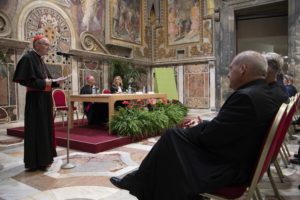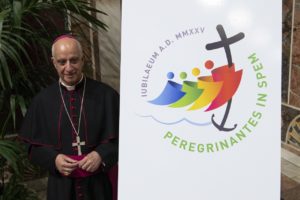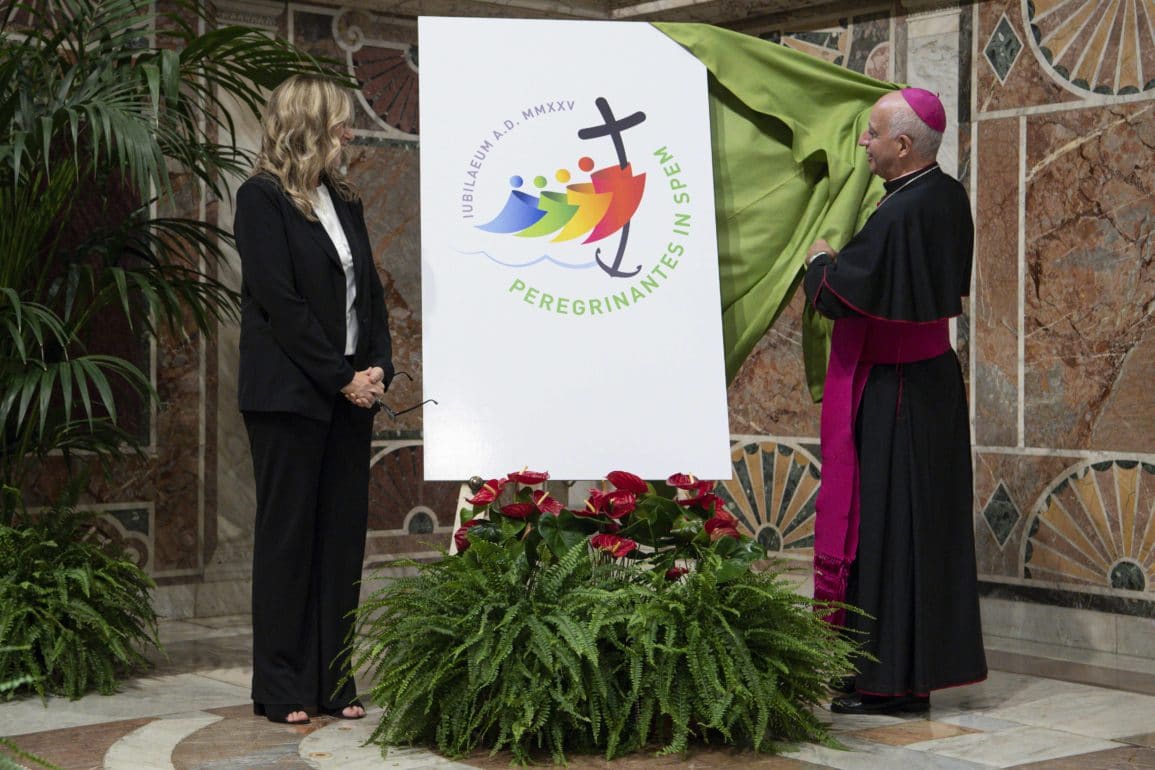The celebration of an ordinary Jubilee entails years of preparation because of the demands involved in such an event. When the Pope opens the Holy Door of St. Peter’s, officially initiating the Jubilee, and subsequently the Doors of the other papal basilicas, pilgrims will be ushered into a long-awaited spiritual experience and they will be eager to partake in it in a way that is in keeping with the meaning of a Jubilee. In these years of preparation, it is especially important to provide the particular Churches scattered throughout the world with tools that foster pastoral care that will most effectively convey the dynamic momentum necessary so that the Jubilee can be a truly ecclesial event that sustains faith and is a precursor for evangelization.
Pope Francis has asked that these two years leading up to the Jubilee be focused on two particular themes.
The year 2023 will be devoted to revisiting the fundamental topics of the four Council Constitutions so that the Church can breathe anew the profound and timely teaching produced by Vatican II, whose 60th anniversary will be celebrated on October 11th. For this reason, a series of user-friendly resources, written in appealing language, are being produced to arouse curiosity in those who have no memory of the event and to help them enter into the essence of the Council in order to discover the innovative longing that enabled the Church to consciously enter the third millennium of its history.
The year 2024 will be a year dedicated to prayer aimed at creating a favorable context for the Jubilee and helping pilgrims to prepare for this primarily spiritual event in a consistent and fruitful manner. In due time, information will be given about the more specific events that will accompany these two years, in order to give an initial preparatory overview. These two years will also allow the city of Rome and the country of Italy to once again display the best of their tradition of hospitality, which over the centuries has become patria communis. I would like to thank the Italian Government, with special mention to the Minister for Tourism, the Hon. Massimo Garavaglia, the Mayor of Rome and Jubilee Commissioner, the Hon. Roberto Gualtieri, and the President of the Lazio Region, the Hon. Nicola Zingaretti. I would also like to thank the various administrative authorities and those associated with them, first and foremost the Fondazione Roma in the person of its President Emeritus, Prof. Emmanuele Emanuele, for the great attention they have given to the Jubilee and for the close cooperation that has ensued for several months, fully aware of the importance of the event and its religious, cultural and social relevance.

Every Holy Year in the history of the Church has taken on its full meaning when it is placed within the historical context that humanity is experiencing at that time and particularly when it is able to read the signs of anxiety and unrest combined with people’s perceived expectations. The vulnerability experienced in recent years, together with the fear of the violence of wars, only makes the human condition more paradoxical: on the one hand, to feel the overwhelming power of technology which determines their days; on the other hand, to feel uncertain and confused about their future. This has given rise to the urgency to live the upcoming Jubilee in the light of hope.
“Pilgrims of Hope” is the motto that has been chosen for the event. It expresses the need to make sense of the present so that it can be preparatory for a real thrust into the future in order to embrace and respond to the various challenges that arise from time to time. The symbolic scenario of the Jubilee, therefore, arises from the reality in which it is embedded, captures its colors and shades of meaning, speaks the language of contemporary man and interprets its essential forms. We are taking our first steps into the digital culture. The younger generations are the children of this new world that brings with it perspectives so daunting that they still look like science fiction, coupled with major shortcomings that undermine the historic achievements of truth and freedom, creating a new anthropological paradigm. The upcoming Jubilee cannot avoid entering into this culture, and for this reason we are studying how to communicate in a proactive and direct way by taking on the achievements that science and technology have placed in our hands. It should enable millions of users to become pilgrims also digitally and move along the pilgrim paths grasping the beauty and sacredness of the moment by receiving information, which, while enabling them to recall centuries of history, still demands that they remain rooted in the present with the commitment that this entails.
In this context of great symbolic importance, it is obvious that the essence of the concept be summarized in an image, which can serve as a compass to follow as well as a common expressive denominator permeating across all the elements that revolve around the celebration of the Jubilee event. Hence the official Logo is one of the first things to be created before introducing any of the others. The Jubilee Logo expresses the distinctive spiritual identity and theme, embodying the theological meaning around which this historic event is developed and carried out.
Upon receiving Pope Francis’ letter entrusting this Dicastery with the organization of the Jubilee, we were immediately concerned about how to proceed with the creation of the Logo. It was decided to involve everyone, without distinction, by launching an International Competition. Guidelines were provided for participating with one’s own design from February 22 to May 20. Students, graphic design studios, religious institutes, professionals and art scholars participated in the Competition and were challenged with the theme of pilgrimage and hope, which is certainly not easy to represent. A total of 294 entries were received from 213 cities and 48 different countries. Participants ranged in age from 6 to 83. In fact, many hand-drawn designs were received from children from all over the world, and it was really moving to go through these drawings which were the fruit of imagination and simple faith. In evaluating the various projects, some recurring graphic elements could be recognized: in addition to the cross as the goal to be reached, a considerable amount of space was given to the theme of pilgrimage, depicted with footprints, paths, roads, pilgrims on their way with bag and staff – all more or less stylized; there was no shortage of boats and vessels with unfurled sails! Many used the metaphor of light radiating from a star, a beacon or a wide-open window. There was no shortage of images of the seashell, the tree, the flame, the dove and the mountains. Liveliness and vibrancy of colors were common to many of the entries. All in all, imagination and creativity were certainly not lacking.
We are deeply grateful to all participants in the Competition for investing their time and resources to create an original project, accomplished with imagination and skill. All the projects were greatly appreciated because, in addition to focusing on the event, they expressed a composite picture, depicting different cultural awarenesses with respect to the same symbolic core. Once the Competition was over, the Judging Committee was convened to judge the projects. The commission, consisting of iconographers, graphic designers, art and brand experts, architects and some pastors, evaluated the proposals according to three criteria: pastoral, to ensure that the Jubilee message can be easily understood; technical-graphic, to ensure good graphic workmanship that allows reproducibility; and aesthetic, to ensure that the design is well done and appealing. During the judging, the works were identified only by a number so that the author remained anonymous. On June 11th, I submitted the three final projects to Pope Francis to select the one that struck him the most. The choice was not easy for him either. After looking at the projects several times and expressing his preference, the project of Giacomo Travisani was chosen.

Before turning the floor over to him, I would like to give an initial theological explanation of the Logo in order to ensure a clear understanding. The Logo shows four stylized figures to indicate all of humanity from the four corners of the earth. They are each embracing another, indicating the solidarity and brotherhood that must unite peoples. It should be noted that the first figure is clinging to the cross. The underlying waves are choppy to indicate that the pilgrimage of life is not always on calm waters. Oftentimes personal circumstances and world events call for a greater sense of hope. This is why the lower part of the Cross is elongated turning into an anchor, which dominates the movement of the waves. As is well known, the anchor has often been used as a metaphor for hope. In fact, in maritime jargon, the hope anchor is the name given to the spare anchor, used by vessels for emergency maneuvers to stabilize the ship during storms. It should be noted that the image shows how the pilgrim’s journey is not individual, but rather communal, with the signs of a growing dynamism that moves more and more toward the Cross. The Cross is by no means static, but it, too,
is dynamic, bending toward and meeting humanity as if not to leave it alone, but rather offering the certainty of its presence and the reassurance of hope. Finally, the Jubilee 2025 Motto, Peregrinantes in Spem is clearly visible in the color green.
The Logo officially certifies the initiatives, projects, communications and events that will be proposed for the preparation and celebration of the 2025 Jubilee.
In these days, the 115 Bishops’ Conferences are being contacted asking them to designate a representative who will be responsible for maintaining constant communication with the Dicastery and vice versa. The Logo may be used by all communities free of charge exclusively for non-profit pastoral initiatives. While the use of the Logo for national or international commercial purposes at national or international levels is bound by copyright and is administered by the Dicastery.
After the summer, the official Jubilee website and related app will be available. Both will be tools to help pilgrims participate fully in the proposed events, facilitating the spiritual and cultural experience of the city of Rome. In fact, in addition to the important Pilgrim’s Charter, the Jubilee portal will contain news, historical notes, practical information, services and multimedia tools, in ten languages available to the pilgrim and easily accessible for people with disabilities.
Finally, it is possible to make a list of Major Events for which specific preparation has been required so they can be added to the daily events and those of individual dioceses.
A first outline could consist of the following categories: Families, Children, Youth, Movements and Associations, Elderly, Grandparents, Disabled, Sports, Sick and Health Care, Universities, World of Work, Choirs and Choruses, Confraternities, Priests, Consecrated Persons, Eastern Catholics, Catechists, the Poor, Prisoners, and many others that will respond to the requests and needs of the various categories.
The calendar will be ready by the end of the year so as to allow adequate organizational time for pilgrims and related agencies.
We hope to continue to find the same active cooperation and, above all, to live these months of preparation with the utmost enthusiasm that a Jubilee dedicated to Hope demands. Making the words of Pope Francis our own: “We must fan the flame of hope that has been given us, and help everyone to gain new strength and certainty by looking to the future with an open spirit, a trusting heart and far-sighted vision. The forthcoming Jubilee can contribute greatly to restoring a climate of hope and trust as a prelude to the renewal and rebirth that we so urgently desire.”










